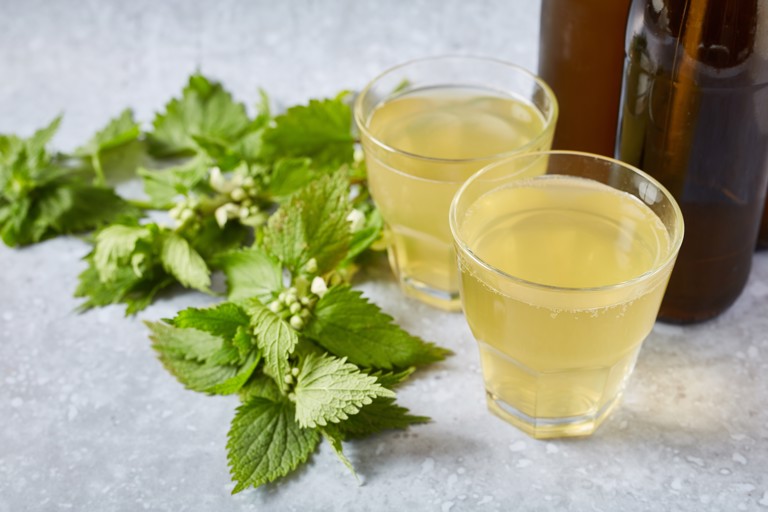Nettle Beer

Nettles are nutritious and tasty as well as having many health benefits, one of which is being an effective diuretic - you have been warned!
If thick gloves and long sleeves are worn the risk of being stung is minimal, but take care when handling the tips after picking as they are still 'armed'. Forget dock leaves and sprays, the best remedy for nettle stings is to strip the leaves from the stem of a nettle and split it lengthways with a knife; rub the pith and sap on the sting as soon as you feel it. This ironic cure works quickly but it is wise to prepare the remedy before picking so that stings can be treated at once.
Nettles for wine and beer are best harvested in late spring and early summer, as later in the year they become too bitter. Use only the tips and top few leaves, and try to pick from the youngest plants. If the nettles are flowering only use the leaves and avoid the tips which carry the flowers. It is difficult to measure an accurate quantity of tips, the most reliable technique is to place them in to a measuring jug and compress them firmly but gently by hand. Fortunately, the amount of nettle tips needed is not crucial; just make sure they are fresh and young. For nettle beer the imprecise but practical measure is a carrier bag, full but not bursting.
To make 4 gallons (The quantities can be adjusted for smaller or larger brews but use the same amount of yeast and priming sugar.)
Ingredients:
- 3 carrier bags fresh young nettle tips
- 2 ½ kg sugar
- 80 g cream of tartar
- 5 lemons (juice of)
- 2 tsp bakers’ yeast (brewing yeast can be used but avoid wine yeast)
Method:
- Boil the nettles in 2 gallons of water for 15 minutes then strain the liquor into a fermenting vessel.
- Dissolve sugar into the liquor.
- Make up to 4 gallons with cold water, add the lemon juice and cream of tartar.
- When the liquor has cooled to body temperature add yeast, leave to ferment.
- After 5 days fermentation should be less vigorous and the beer is ready for bottling.
Bottling:
Only use bottles suitable for fizzy drinks; wine or squash bottles will explode without warning and can be very dangerous. 2 litre plastic bottles with a secure screw top are fine, as are glass beer bottles.
- Sterilise and rinse the bottles and tops thoroughly.
- Prime each bottle by putting no more than 1 level teaspoon of sugar per litre (½ a teaspoon per pint) into each bottle, use a dry funnel to avoid spillage.
- Siphon the beer into the bottles, avoid disturbing the sediment at the bottom of the fermenting bin
- Seal the bottles and leave to stand for 1 week. During this time the priming sugar will cause the yeast in the beer to ferment so that the beer sparkles.
Nettle beer is best served chilled; keep a few bottles in the fridge. The beer may be cloudy, this is normal and due to the yeast. Pour the beer steadily to avoid the yeast sediment entering the glass. If using large bottles decant the beer into a jug first. The juice of oranges can be used instead of lemons, or a combination of the two. A variation is to add bruised root ginger at the start of fermentation and leave it in the beer until bottling, vary the quantity according to taste.
